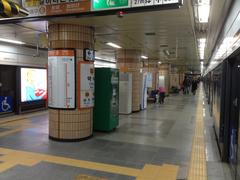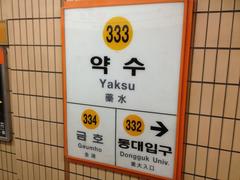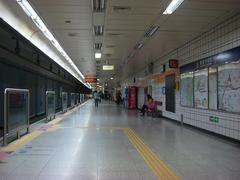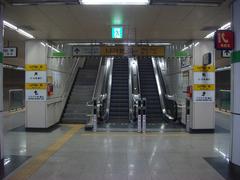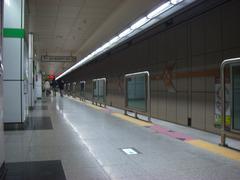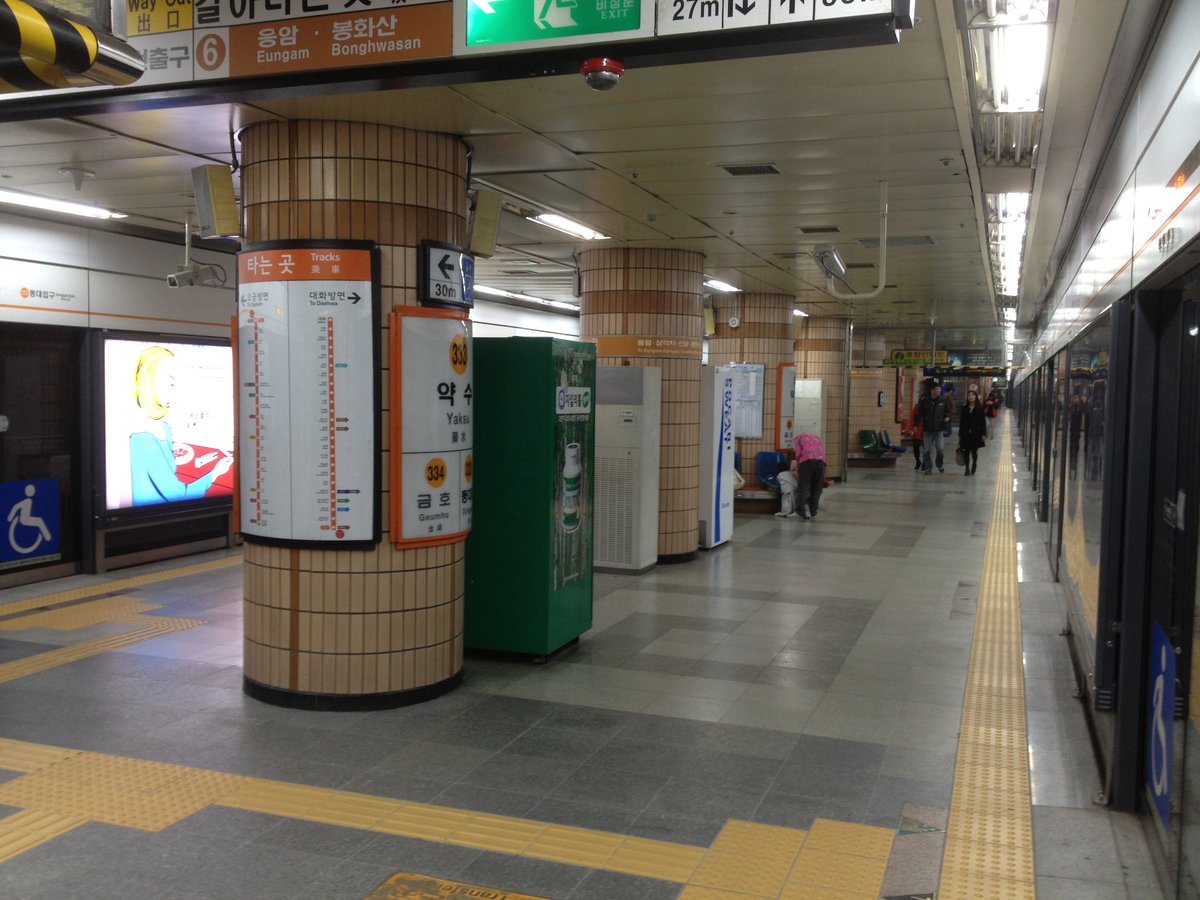
Yaksu Station Visiting Hours, Tickets, and Travel Guide in Seoul, South Korea
Date: 14/06/2025
Introduction to Yaksu Station
Yaksu Station (약수역), centrally located in Jung-gu, Seoul, is an important hub in the city’s vast subway network. Its name, which translates to “medicinal water,” recalls the area’s once-famous healing springs and highlights the connection between Seoul’s modern landscape and its natural and cultural roots. Since opening in 1985 as part of Line 3 and becoming an interchange with Line 6 in 2001, Yaksu Station has grown into a bustling crossroads for daily commuters and a convenient entry point for visitors. The station offers modern amenities, multilingual signage, and easy ticketing through options like the T-money card. Nearby, you’ll find a wealth of cultural attractions, from traditional markets to historic sites such as Dongguk University and vibrant neighborhoods like Itaewon and Dongdaemun. This guide provides essential information on Yaksu Station’s history, facilities, nearby points of interest, and practical tips for an enriching visit to this key Seoul locale (Mapcarta, Lonely Planet, Wikiwand).
Table of Contents
- Origins and Naming of Yaksu Station
- Development and Role in Seoul’s Transit System
- Visiting Yaksu Station: Hours & Ticket Info
- Station Architecture and Layout
- Attractions Near Yaksu Station
- Yaksu’s Role in Urban Mobility
- Historical and Cultural Context
- Notable Events and Recent Developments
- Tips for First-Time Visitors
- Visual & Media Recommendations
- FAQ
- Additional Resources
Origins and Naming of Yaksu Station
Yaksu Station takes its name from Yaksu-dong, inspired by a mineral spring formerly believed to offer healing benefits. “Yak” means medicine and “su” means water in Korean. This reflects the long-standing practice in Korean place-naming of honoring natural resources and the mutual shaping of the city’s development and its geography (Mapcarta).
Development and Role in Seoul’s Transit System
Opened on October 18, 1985, as part of Line 3, Yaksu Station quickly became essential for connecting Seoul’s central and southern districts. Its expansion as an interchange with Line 6 in 2001 significantly improved accessibility to previously underserved neighborhoods, transforming Yaksu into a vital transfer station and increasing its daily passenger volume. Today, it efficiently links key districts, supporting both local and citywide mobility.
Visiting Yaksu Station: Hours & Ticket Info
- Operating Hours: Subway trains run from approximately 5:30 AM to midnight.
- Tickets: Purchase single-journey tickets or use a rechargeable T-money card, available at station vending machines with multilingual instructions. T-money cards are valid across Seoul’s subways and buses.
- Accessibility: Yaksu Station is equipped with elevators, escalators, tactile paving, and accessible restrooms. Multilingual signage and helpful staff ensure smooth navigation for all visitors.
Station Architecture and Layout
Yaksu Station is an underground facility with multiple levels for Lines 3 and 6. Its design emphasizes clear signage, wide corridors, and practical layouts, with exits leading directly to main roads, residential complexes, and commercial areas. The station has modernized over time, incorporating digital information displays and improved lighting while maintaining the functional Metro style of the 1980s and early 2000s.
Attractions Near Yaksu Station
- Dongguk University: A Buddhist-affiliated university with picturesque gardens and traditional architecture. Open daily from 9:00 AM to 6:00 PM (Dongguk University).
- Jogye Temple: A major center for Korean Zen Buddhism, offering tranquility and cultural insight.
- Dongdaemun Historic District: Famous for ancient city walls and Heunginjimun Gate, as well as lively markets and shopping complexes.
- Itaewon & Hannam-dong: Accessible by Line 6, these neighborhoods are known for their multicultural vibe, trendy cafes, and dynamic nightlife.
- Namsan Park & N Seoul Tower: Easily reached from Yaksu, these offer green spaces, observation decks, and panoramic city views (N Seoul Tower).
Yaksu’s Role in Urban Mobility
As a transfer hub between Lines 3 and 6, Yaksu Station is key for navigating Seoul. Line 3 connects northern districts to the affluent south, including Gangnam, while Line 6 links culturally rich areas such as Itaewon and Sangsu. Its Jung-gu location—an area blending residential, commercial, and governmental functions—makes Yaksu an essential transit point, enhanced by integrated bus connections (Seoul Metro Official Website).
Historical and Cultural Context
The Yaksu-dong neighborhood has evolved from a site famed for medicinal springs to a modern urban district, balancing high-rise apartments, small businesses, and traditional markets. The station’s presence has spurred economic activity and helped preserve local culture, supporting a vibrant community that bridges Seoul’s history with its cosmopolitan present (Wikiwand).
Notable Events and Recent Developments
Yaksu Station’s development mirrors Seoul’s rapid modernization, especially during the 1980s and the run-up to the 1988 Olympics. The addition of Line 6 in 2001 addressed transport gaps and sparked infrastructure upgrades. Recent years have seen Yaksu adopt digital ticketing, enhanced security, and improved accessibility, reflecting Seoul Metro’s ongoing commitment to inclusivity and convenience.
Tips for First-Time Visitors
- Get a T-money card for ease of travel.
- Check station exits to quickly reach your destination.
- Visit attractions during off-peak hours for a more relaxed experience.
- Enjoy local food: Nearby markets and eateries offer authentic Korean cuisine.
- Ask for help: Staff are available for guidance, and English signage is present.
Visual & Media Recommendations
Use virtual tours and interactive maps from the Seoul Metro website to familiarize yourself with the station layout. Capture photos of Yaksu’s platforms, nearby markets, or N Seoul Tower, and use descriptive image tags like “Yaksu Station platform Seoul” for better online sharing.
FAQ
Q: What are Yaksu Station’s operating hours?
A: Daily from about 5:30 AM to midnight.
Q: How do I buy tickets?
A: At automated machines or with a T-money card.
Q: Is Yaksu Station accessible?
A: Yes—elevators, tactile paving, and barrier-free restrooms are available.
Q: Are there attractions nearby?
A: Yes, including Dongguk University, Jogye Temple, Dongdaemun, and Namsan Park.
Q: Is it possible to transfer between subway lines?
A: Yes, between Line 3 and Line 6 at Yaksu.
Additional Resources
Exploring the Yaksu Neighborhood: Attractions & Local Tips
Local Atmosphere
Yaksu is a residential area offering a calm, authentic Seoul experience, with apartments, local shops, and family-run restaurants. Its community vibe and walkable streets set it apart from busier tourist districts (Wikiwand).
Shopping & Dining
You’ll find a variety of local cafes, bakeries, and affordable Korean restaurants. While Yaksu lacks a major traditional market, Gwangjang Market—a short subway ride away—is renowned for its classic street food and vibrant atmosphere (Lonely Planet).
Points of Interest
- Dongguk University: Open daily, hosts cultural events.
- Namsan Park & N Seoul Tower: Open 10:00 AM–11:00 PM; panoramic city views (N Seoul Tower).
- Local Alleys: Discover murals, small eateries, and hidden shops.
Cultural Experiences
Yaksu occasionally hosts community events and seasonal markets. Nearby Insadong (reachable by subway) is famed for traditional tea houses and Korean desserts (Seoul Korea Asia).
Practical Tips
- Transport: Yaksu Station is on Lines 3 and 6, with elevators and escalators for accessibility.
- Safety: The area is safe and suitable for solo travelers and families.
- Best Seasons: Visit in spring or autumn for pleasant weather.
FAQ
Q1: What are N Seoul Tower’s hours?
A1: 10:00 AM–11:00 PM daily. (N Seoul Tower)
Q2: Is Dongguk University free to visit?
A2: Yes, during regular hours (9:00 AM–6:00 PM).
Q3: How to reach Gwangjang Market?
A3: Take Line 6 from Yaksu to Dongdaemun History & Culture Park Station, then transfer to Line 1; or take a taxi for a short ride.
Q4: Are guided tours available?
A4: Some city walking tours include Yaksu; inquire with local providers.
Q5: Is Yaksu accessible for mobility-impaired visitors?
A5: Yes, though some alleys may be narrow or uneven.
Sample Itinerary
- Morning: Coffee at a local café and a neighborhood stroll.
- Midday: Visit Dongguk University or hike in Namsan Park, ending at N Seoul Tower.
- Afternoon: Lunch at a neighborhood eatery; explore alleys and local life.
- Evening: Experience Itaewon or Insadong for dining or cultural activities.
Summary & Final Tips
Yaksu Station is more than a transfer point; it’s the gateway to a blend of historical, cultural, and modern experiences. Explore the area’s tranquil neighborhoods, sample local cuisine, and enjoy the seamless connectivity to Seoul’s must-see sites. For real-time transit updates and personalized travel planning, download the Audiala app.
References & Further Reading
- Exploring Yaksu Station: A Visitor’s Guide to Seoul’s Historic Transit Hub, 2025 (Mapcarta)
- Visiting Gyeongbokgung Palace: History, Tickets, and Travel Tips, 2025 (Official Gyeongbokgung Palace Website)
- Yaksu Neighborhood Guide: Visiting Hours, Attractions, and Local Tips in Seoul, 2025 (Wikiwand)
- Lonely Planet, Top Things to Do in Seoul, 2025 (Lonely Planet)
- Seoul Metro Official Website, 2025 (Seoul Metro Official Website)
- Dongguk University Official Website, 2025 (Dongguk University)
- N Seoul Tower Official Website, 2025 (N Seoul Tower)
- Seoul Korea Asia
